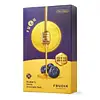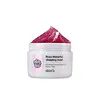What's inside
What's inside
 Key Ingredients
Key Ingredients

 Benefits
Benefits

 Concerns
Concerns

 Ingredients Side-by-side
Ingredients Side-by-side

Water
Skin ConditioningButylene Glycol
HumectantCetyl Ethylhexanoate
EmollientPentaerythrityl Tetraethylhexanoate
EmollientVaccinium Angustifolium Fruit Extract
Skin ProtectingPolyglyceryl-3 Methylglucose Distearate
EmulsifyingGlyceryl Stearate Se
EmulsifyingGlycerin
HumectantDiisostearyl Malate
EmollientButyrospermum Parkii Butter
Skin ConditioningCetyl Alcohol
EmollientTrehalose
HumectantGlyceryl Caprylate
EmollientBetaine
HumectantCoco-Caprylate/Caprate
EmollientStearyl Alcohol
EmollientTromethamine
BufferingCoptis Japonica Root Extract
Skin ConditioningCarbomer
Emulsion Stabilising1,2-Hexanediol
Skin ConditioningMyristyl Alcohol
EmollientXanthan Gum
EmulsifyingAcrylates/C10-30 Alkyl Acrylate Crosspolymer
Emulsion StabilisingLauryl Alcohol
EmollientHydrogenated Olive Oil Unsaponifiables
EmollientDisodium EDTA
Hyaluronic Acid
HumectantSodium Hyaluronate
HumectantPanthenol
Skin ConditioningTheobroma Cacao Extract
Skin ConditioningVitis Vinifera Seed Oil
EmollientPrunus Armeniaca Kernel Oil
MaskingRibes Nigrum Leaf Extract
PerfumingHoney Extract
HumectantSolanum Lycopersicum Seed Oil
EmollientPunica Granatum Seed Oil
EmollientMangifera Indica Seed Oil
EmollientCitrus Paradisi Seed Oil
PerfumingCitric Acid
BufferingTocopherol
AntioxidantChlorphenesin
AntimicrobialWater, Butylene Glycol, Cetyl Ethylhexanoate, Pentaerythrityl Tetraethylhexanoate, Vaccinium Angustifolium Fruit Extract, Polyglyceryl-3 Methylglucose Distearate, Glyceryl Stearate Se, Glycerin, Diisostearyl Malate, Butyrospermum Parkii Butter, Cetyl Alcohol, Trehalose, Glyceryl Caprylate, Betaine, Coco-Caprylate/Caprate, Stearyl Alcohol, Tromethamine, Coptis Japonica Root Extract, Carbomer, 1,2-Hexanediol, Myristyl Alcohol, Xanthan Gum, Acrylates/C10-30 Alkyl Acrylate Crosspolymer, Lauryl Alcohol, Hydrogenated Olive Oil Unsaponifiables, Disodium EDTA, Hyaluronic Acid, Sodium Hyaluronate, Panthenol, Theobroma Cacao Extract, Vitis Vinifera Seed Oil, Prunus Armeniaca Kernel Oil, Ribes Nigrum Leaf Extract, Honey Extract, Solanum Lycopersicum Seed Oil, Punica Granatum Seed Oil, Mangifera Indica Seed Oil, Citrus Paradisi Seed Oil, Citric Acid, Tocopherol, Chlorphenesin
Water
Skin ConditioningGlycerin
HumectantCyclopentasiloxane
EmollientPropanediol
SolventDimethicone
EmollientNiacinamide
SmoothingDimethicone/PEG-10/15 Crosspolymer
Butylene Glycol
HumectantRosa Damascena Flower Water
MaskingCitric Acid
BufferingGlycolic Acid
BufferingLactic Acid
BufferingMalic Acid
BufferingPyruvic Acid
MaskingTartaric Acid
BufferingTrehalose
HumectantMalpighia Emarginata Fruit Extract
Skin ConditioningTerminalia Ferdinandiana Fruit Extract
AntioxidantEuterpe Oleracea Fruit Extract
Ficus Carica Fruit Extract
HumectantMorus Alba Fruit Extract
AntioxidantCeramide 3
Skin ConditioningBetaine
HumectantTheobroma Cacao Extract
Skin ConditioningSodium Citrate
BufferingBenzophenone-5
UV AbsorberDisodium EDTA
Phenoxyethanol
PreservativeChlorphenesin
AntimicrobialSodium Benzoate
MaskingPotassium Sorbate
PreservativeCI 17200
Cosmetic ColorantCI 42090
Cosmetic ColorantParfum
MaskingWater, Glycerin, Cyclopentasiloxane, Propanediol, Dimethicone, Niacinamide, Dimethicone/PEG-10/15 Crosspolymer, Butylene Glycol, Rosa Damascena Flower Water, Citric Acid, Glycolic Acid, Lactic Acid, Malic Acid, Pyruvic Acid, Tartaric Acid, Trehalose, Malpighia Emarginata Fruit Extract, Terminalia Ferdinandiana Fruit Extract, Euterpe Oleracea Fruit Extract, Ficus Carica Fruit Extract, Morus Alba Fruit Extract, Ceramide 3, Betaine, Theobroma Cacao Extract, Sodium Citrate, Benzophenone-5, Disodium EDTA, Phenoxyethanol, Chlorphenesin, Sodium Benzoate, Potassium Sorbate, CI 17200, CI 42090, Parfum
 Reviews
Reviews

Ingredients Explained
These ingredients are found in both products.
Ingredients higher up in an ingredient list are typically present in a larger amount.
Betaine is a common humectant (a substance that promotes retention of moisture). It's known to be gentle on the skin and can help balance hydration.
This ingredient is best for improving hydration and soothing irritated skin. Studies also show it helps even out skin tone.
Fun fact: Betaine is naturally created in the skin and body. The kind found within cosmetic products can be either plant-derived or synthetic.
Another name for betaine is trimethylglycine.
Learn more about BetaineButylene Glycol (or BG) is used within cosmetic products for a few different reasons:
Overall, Butylene Glycol is a safe and well-rounded ingredient that works well with other ingredients.
Though this ingredient works well with most skin types, some people with sensitive skin may experience a reaction such as allergic rashes, closed comedones, or itchiness.
Learn more about Butylene GlycolChlorphenesin is a synthetic preservative. It helps protect a product against bacteria in order to extend shelf life. In most cases, Chlorphenesin is paired with other preservatives such as phenoxyethanol and caprylyl glycol.
Chlorphenesin is a biocide. This means it is able to help fight the microorganisms on our skin. It is also able to fight odor-releasing bacteria.
Chlorphenesin is soluble in both water and glycerin.
Studies show Chlorphenesin is easily absorbed by our skin. You should speak with a skincare professional if you have concerns about using Chlorphenesin.
Learn more about ChlorphenesinCitric Acid is an alpha hydroxy acid (AHA) naturally found in citrus fruits like oranges, lemons, and limes.
Like other AHAs, citric acid can exfoliate skin by breaking down the bonds that hold dead skin cells together. This helps reveal smoother and brighter skin underneath.
However, this exfoliating effect only happens at high concentrations (20%) which can be hard to find in cosmetic products.
Due to this, citric acid is usually included in small amounts as a pH adjuster. This helps keep products slightly more acidic and compatible with skin's natural pH.
In skincare formulas, citric acid can:
While it can provide some skin benefits, research shows lactic acid and glycolic acid are generally more effective and less irritating exfoliants.
Most citric acid used in skincare today is made by fermenting sugars (usually from molasses). This synthetic version is identical to the natural citrus form but easier to stabilize and use in formulations.
Read more about some other popular AHA's here:
Learn more about Citric AcidDisodium EDTA plays a role in making products more stable by aiding other preservatives.
It is a chelating agent, meaning it neutralizes metal ions that may be found in a product.
Disodium EDTA is a salt of edetic acid and is found to be safe in cosmetic ingredients.
Learn more about Disodium EDTAGlycerin is already naturally found in your skin. It helps moisturize and protect your skin.
A study from 2016 found glycerin to be more effective as a humectant than AHAs and hyaluronic acid.
As a humectant, it helps the skin stay hydrated by pulling moisture to your skin. The low molecular weight of glycerin allows it to pull moisture into the deeper layers of your skin.
Hydrated skin improves your skin barrier; Your skin barrier helps protect against irritants and bacteria.
Glycerin has also been found to have antimicrobial and antiviral properties. Due to these properties, glycerin is often used in wound and burn treatments.
In cosmetics, glycerin is usually derived from plants such as soybean or palm. However, it can also be sourced from animals, such as tallow or animal fat.
This ingredient is organic, colorless, odorless, and non-toxic.
Glycerin is the name for this ingredient in American English. British English uses Glycerol/Glycerine.
Learn more about GlycerinThis ingredient is extracted from the seeds of the cocoa tree.
Cacao seeds contain antioxidants known as polyphenols. These include flavonoids, procyanidins, and epicatechins.
Studies show these polyphenols help improve skin health.
The more famous ingredient from cocoa tree is cocoa butter.
Learn more about Theobroma Cacao ExtractTrehalose is a disaccharide made of two glucose molecules (glucose is sugar!). Trehalose is used to help moisturize skin. It also has antioxidant properties.
As a humectant, trehalose helps draw moisture from the air to your skin. This helps keep your skin hydrated.
Due to its antioxidant properties, trehalose may help with signs of aging. Antioxidants help fight free-radical molecules, unstable molecules that may damage your skin.
In medicine, trehalose and hyaluronic acid are used to help treat dry eyes.
Some animals, plants, and bacteria create trehalose as a source of energy to survive freeze or lack of water.
Learn more about TrehaloseWater. It's the most common cosmetic ingredient of all. You'll usually see it at the top of ingredient lists, meaning that it makes up the largest part of the product.
So why is it so popular? Water most often acts as a solvent - this means that it helps dissolve other ingredients into the formulation.
You'll also recognize water as that liquid we all need to stay alive. If you see this, drink a glass of water. Stay hydrated!
Learn more about Water